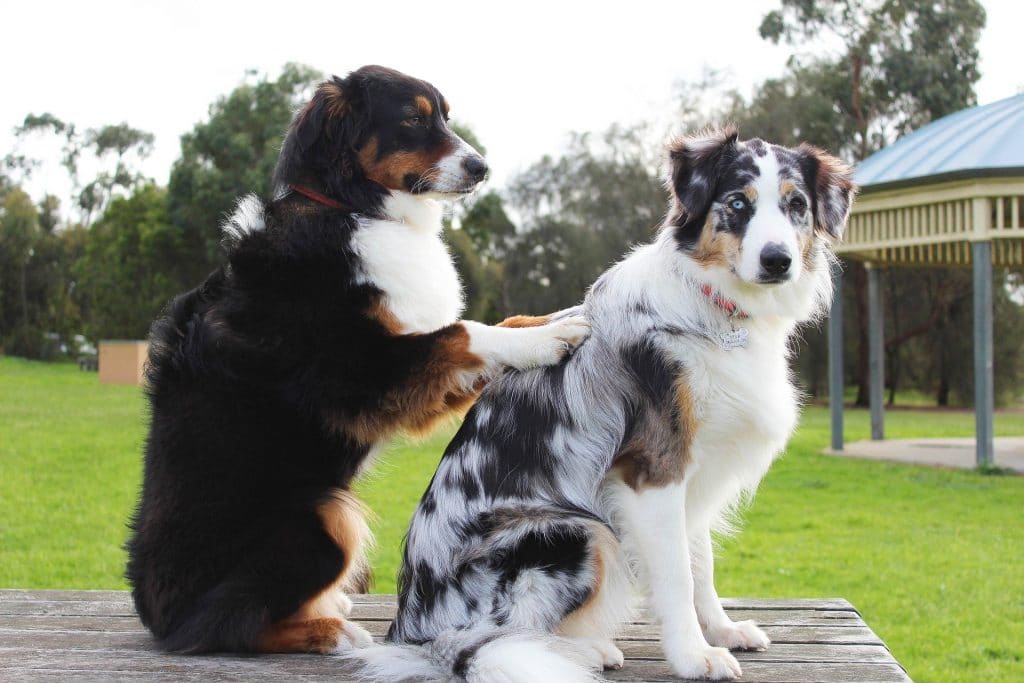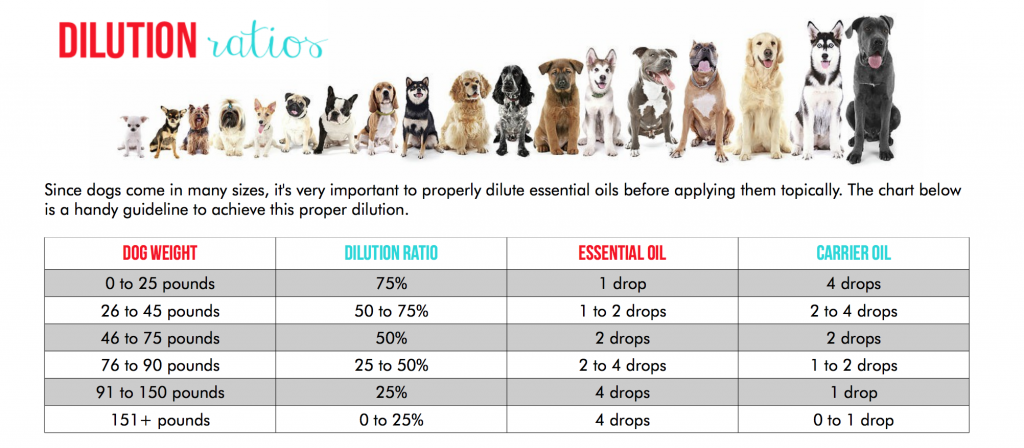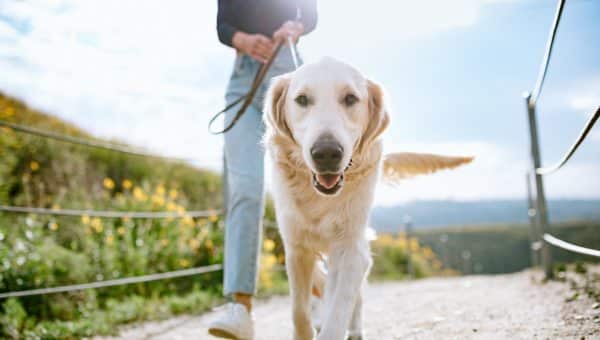- This post contains affiliate links. Read more here.
- Not a substitute for professional veterinary help.
You may have heard about the healing properties of essential oils. Could they have similar effects on our dogs? Are essential oils safe for dogs? Which essential oils are bad for dogs?
With the recent rise in interest in essential oils thanks to companies like doTerra, many pet parents are curious about this approach, but aren’t sure whether it’s a good idea.
As a vet tech, I’ve often heard the question “are essential oils bad for dogs?” I wanted to dig into the issue to find out. Here’s what I discovered.
Essential oils safe for dogs
Below is a short list of essential oils safe for dogs, recommended by the experts:
- Lavender: Universal oil. Useful in conditioning patients to a safe space. May help allergies, burns, ulcers, insomnia, anxiety, and car sickness, to name a few. Not for use with cats.
- Copaiba: Supports the cardiovascular, immune, digestive, urinary, respiratory, musculoskeletal, and nervous systems.
- Frankincense: Promotes cellular health and immunity. Supports the nervous system and digestive tract.
- Peppermint: Supports the respiratory system and soothes aching joints.
- Petitgrain: Helps to calm the nervous and digestive systems. Good for dogs with stress or anxiety.
Essential oils bad for dogs
Certain oils can be toxic to dogs when ingested or when coming into contact with the skin. Essential oils bad for dogs include:
- Tea tree: Toxicity symptoms include depression, loss of coordination, paralysis of the rear legs, vomiting, low body temperature, and skin irritation.
- Cinnamon: Toxicity symptoms include low blood sugar, liver disease, vomiting, diarrhea, and fluctuations in heart rate.
- Citrus: Toxicity symptoms include skin irritation, agitation or lethargy, vomiting, tremors, and seizures.
- Pennyroyal: Toxicity symptoms include vomiting and diarrhea—often bloody—as a result of liver failure. You may notice your dog acting lethargic. Seek immediate veterinary care as Pennyroyal toxicity can cause death in dogs.
- Pine: skin or stomach irritation, vomiting (possibly bloody), drooling, weakness, loss of coordination, damage to the central nervous system, and potential renal and liver effects.
- Sweet birch: Toxicity symptoms include severe gastrointestinal ulcers, kidney failure, seizures, and death.
- Wintergreen: Toxicity symptoms include vomiting due to severe stomach upset and ulcers. Wintergreen toxicity can also lead to renal and liver failure.
- Ylang ylang: Toxicity symptoms include difficulty breathing, weakness, unstable walking, and vomiting.
How is quality determined?
Essential oils are extracted from plants and the quality of the oil is impacted by several conditions—the sunlight, altitude, and even how much water a plant receives. Aromatherapy is the use of essential oils – the concentrated, aromatic oils extracted from plants through distillation, most often by steam.
Essential oils produced for aromatherapy use are typically processed with a great deal of care. Why? Well, they’re costly! For instance, 220 pounds of lavender yield only seven pounds of lavender essential oils. The author of Holistic Aromatherapy for Animals, Kristen Leigh Bell, writes, “oils that are produced specifically for the aromatherapy industry are typically made with the same care and attention that goes into a fine bottle of wine.”
Purity, however, doesn’t equate to safety—just like the word “natural” doesn’t mean “safe to use.” Essential oils are very potent because they’re so concentrated. That’s why they’re best diffused via steam and must never be given to your pet to ingest.
Most veterinary experts also advise against using them topically. If used topically, they must be diluted in what’s known as a carrier oil; always consult with a vet before attempting this.
Even if you’re using an essential oil safe for dogs, care must be taken both in the amount of exposure as well as the concentration of the oil. Some oils can go from safe to toxic if used too much, and others can be accidentally absorbed through the skin or cause contact burns when improperly applied.
How can essential oils and aromatherapy help dogs?
Essential oils safe for dogs are thought to help with everything from skin irritations to fighting fleas. Lavender is popular for dogs because of its reported calming effects, for example.
My dog Sherman suffers from anxiety, and we’ve had luck using lavender to help calm his nerves. We add a few drops of lavender to the essential oil diffuser we have in our kitchen before we leave the house.
The holistic veterinary community has embraced their use. One recent survey of holistic vets, in fact, reveals that some veterinarians use essential oils in disparate ways: diffusing lavender in waiting and exam rooms, using essential oils for odor control, giving a light massage with frankincense, and more.
Veterinarian Dr. Janet Roark, known as the “essential oil vet,” has many good links and resources available about the benefits of essential oils for pets on her website.
However, there is scant research on the topic, and thus, a lack of hard evidence as to whether essential oils truly provide all of their purported benefits.
If they’re not used properly, certain essential oils pose a risk to dogs. Cats are even more sensitive to these oils, and birds shouldn’t be around them at all. So even if you use essential oils safe for dogs, you may be putting other members of your household at risk.
If you’re interested in trying essential oils with your pet, be sure to get professional guidance.
How to use essential oils with your dog
Based on research, remember this about using essential oils with your pets: LESS IS MORE.
Always start with therapeutic grade essential oils, and double-check that you aren’t using an essential oil bad for dogs.
- A rough guideline is to add about 3-6 drops of essential oils to 1 oz. (30 ml) of carrier oil.
- Use a smaller amount of diluted oils on small dogs vs. big dogs – and fewer amounts of diluted oils on puppies and senior dogs.
- Use a hydrosol, a water-based byproduct obtained during the steam distillation process of essential oils.
Dr. Roark adds the following precautions about using essential oils with dogs:
- Do not use around eyes, ears, nose, or genitals.
- Exercise caution with pregnant or nursing pets.
- Know your pet’s health status and behavior, and discontinue use if concerns arise.
Note that all of these tips apply to dogs only. In general, essential oils are more dangerous for cats, and you should absolutely check with your veterinarian before considering their use with cats.
More essential oil safety tips
Dogs are more sensitive to essential oils than humans, so even if you’re familiar with them for yourself, remember that it’s a different story with your dog.
- Only use essential oils with your dogs to address a specific, ongoing and active concern – not to “prevent” a health issue.
- Do not add essential oils to your dog’s food or drinking water.
- Avoid using essential oils with puppies under 10 weeks of age and with pregnant or nursing dogs.
- Do not use oils on epileptic dogs or dogs who are seizure-prone.
Symptoms of essential oil poisoning in dogs
If essential oils are kept within reach of your pet, even if they’re essential oils safe for dogs, you run the risk of accidental ingestion.
Watch out for these symptoms:
- Muscle tremors
- Weakness
- Difficulty in walking
- Low body temperature
- Excessive salivation
- Vomiting
- Excessive pawing at mouth or face
- Drooling
If you suspect your dog has ingested an essential oil, call your veterinarian or Pet Poison Helpline (800-213-6680) right away. Early intervention is best.
For more in-depth tips on safety and the use of essential oils with dogs, Kristen Leigh Bell’s book Holistic Aromatherapy for Animals is an excellent and well-regarded guide.
Again, be sure to consult with your vet before trying any essential oils with your dog.







